| Active Distributed Computing Projects - Distributed Human Projects |
|
These links take you to other project categories on this site:
Mathematics Language Art Puzzles/Games Miscellaneous Distributed Human Projects Collaborative Knowledge Bases Charity See the bottom of this page for a description of the icons on the page. |
| Project Information | Project % Complete | Major Supported Platforms |
|---|---|---|
|
On February 19, 2003, DP posted its 1,000th project to PG. In August, 2003, the project set a record of 129,273 pages proofread in one month. On September 3, 2003, DP posted its 2,000th project. On October 15, 2003, PG published its 10,000th ebook, a goal which was set in 1971. On January 14, 2004, DP posted its 3,000th project. On April 8, 2004, DP posted its 4,000th book. On August 21, 2004, DP posted its 5,000th project. On October 8, 2004, DP posted its 5,000th unique title. On February 2, 2005, DP posted its 6,000th unique title. On June 27, 2005, DP posted its 7,000th unique title. On February 8, 2006, DP posted its 8,000th unique title. On September 11, 2006, DP posted its 9,000th unique title. On March 9, 2007, DP posted its 10,000th unique title. On September 12, 2007, DP posted its 11,000th unique title. In September, 2008, DP posted its 14,000th unique title. In October, 2009, DP posted its 16,000th unique title. In June, 2010, DP posted its 18,000th unique title. The project celebrated its tenth anniversary on October 4, 2010. In January, 2011, DP posted its 22,000th unique title. In June, 2012 it posted its 23,000th unique title. On April 10, 2013 it posted its 25,000th unique title. To participate, create an account, then select a proofreading project from a list. A proofreading interface is displayed in your web browser, and you can proofread pages for the project one at a time. The project has personal stats pages and rankings for proofreaders so that each proofreader can see how he or she is doing compared to other proofreaders. You can also become a project manager and prepare proofreading projects for the site, and you can reassemble proof-read projects for submission to Project Gutenberg. Join a discussion forum about this project. Audio versions of some of the books in Project Gutenberg are being created in the Gutenberg Audio Books project. Read a November 15, 2005, interview of Michael Hart, the founder of Project Gutenberg, by Dr. Samuel Vaknin. |
ongoing: 25,074 books completed as of April 26, 2013 |
N/A |
|
The project submitted its first book to Project Gutenberg on February 9, 2004. It submitted its 100th book to Project Gutenberg on March 31, 2005. To participate, create an account, then select a proofreading project from a list. A proofreading interface is displayed in your web browser, and you can proofread pages for the project one at a time. The project has personal stats pages and rankings for proofreaders so that each proofreader can see how he or she is doing compared to other proofreaders. You can also become a project manager and prepare proofreading projects for the site, and you can reassemble proof-read projects for submission to Project Gutenberg. Join a discussion forum about this project. |
ongoing: 787 books completed as of January 27, 2012 |
N/A |
|
To participate, create an account, then select a proofreading project from a list. A proofreading interface is displayed in your web browser, and you can proofread pages for the project one at a time. The project has personal stats pages and rankings for proofreaders so that each proofreader can see how he or she is doing compared to other proofreaders. You can also become a project manager and prepare proofreading projects for the site, and you can reassemble proof-read projects for submission to Project Gutenberg Canada. Join a discussion forum about this project. |
ongoing: 232 books completed |
N/A |
 Twenty Questions,
"the neural net on the Internet," is an experimental
artificial intelligence system which asks you to think of an object and
then tries to quess what the object is by asking you twenty (more or
less) questions. It learns from the answers you give to its questions.
The more people play this game with it, the more it learns. The project
website is also available in Spanish,
French,
German, and other languages.
Twenty Questions,
"the neural net on the Internet," is an experimental
artificial intelligence system which asks you to think of an object and
then tries to quess what the object is by asking you twenty (more or
less) questions. It learns from the answers you give to its questions.
The more people play this game with it, the more it learns. The project
website is also available in Spanish,
French,
German, and other languages.
|
ongoing | N/A |
|
Help The ESP Game label images on the Internet. The project presents a Java applet game to volunteers. A pair of volunteers is shown a series of images and must type the same one-word description of an image within a time limit. The more images the pair tags, and the faster they type the same description, the more points they score. Each volunteer's points accumulate. The project associates a set of one-word descriptions for each of the images it indexes. The images can be searched through the project site. To participate in the project, sign up for a user account, then click on the Play Now button. Your browser should load a Java applet in a new window and provide further instructions for playing the game. |
ongoing: images labeled |
N/A |
 Help develop common sense artificial intelligence at questsin. The project is attempting to "cluster information into sets, made up of related elements (words to start with, followed by concepts, ideas etc) and their potential hierarchies." You can help build the information sets by entering lists of related terms into the interface on the project's main web page. Data collected by the project will eventually be made available to the public in raw form, similar to other projects. For now the project gives immediate results and can be used as a research tool on its own. Learn more about the algorithms behind the project in the project owner's blog. Join a discussion forum about the project. |
ongoing | N/A |
|
Get paid to "complete simple tasks that people do better than computers" in Amazon Mechanical Turk. Participants can choose from many available HITs (Human Intelligence Tasks) to work on, accept a HIT and submit results through the project website, and be paid when their results are approved by the person or group listing the HIT. The money you earn is deposited in your Amazon.com account, and you can transfer it from there into your personal checking account or to your Amazon.com gift certificate balance. You must be 18 or older to participate in the project. |
ongoing |
N/A |
 Help Stardust@Home find grains of interstellar dust in an aerogel particle collector which was returned from NASA's Stardust space probe to Earth on January 15, 2006. Participants (who first go through web-based training and pass a qualification test) can access a "virtual microscope" through a web page and then look for interstellar dust grains in "focus movies" (stacks of microscopic images created from the Stardust Interstellar Dust Collector). The project may have found its first particle on March 7, 2010. From the project website: "Finding the incredibly tiny interstellar dust impacts in the Stardust Interstellar Dust Collector (SIDC) will be extremely difficult. Because dust detectors on the Ulysses and Galileo spacecraft have detected interstellar dust streaming into the solar system, we know there should be about 45 interstellar dust impacts in the SIDC. These impacts can only be found using a high-magnification microscope with a field of view smaller than a grain of salt. But the aerogel collector that we have to search enormous by comparison, about a tenth of a square meter (about a square foot) in size. The job is roughly equivalent to searching for 45 ants in an entire football field, one 5cm by 5cm (2 inch by 2 inch) square at a time! More than 1.6 million individual fields of view will have to be searched to find the interstellar dust grains. We estimate that it would take more than twenty years of continuous scanning for us to search the entire collector by ourselves." As of September 6, 2006 the project has identified several possible interstellar dust tracks. Now the project owners have to figure out the best way to remove the tracks from the aerogel so the tracks can be examined more closely. On Septmeber 18, 2006, the CAPTEM Stardust Oversight Committee met to decide how best to investigate the potential interstellar dust tracks. On September 26, they decided to learn what they can from viewing the tiles from different sides, while experimenting with ways to remove the tracks using the "flight spare" tile. As of October 6, 2006, over 20 million searches have been completed by project participants, and more than 1/4 of of the aerogel collector has been scanned. As of December 1, 2006, "about 600 high-resolution focus movies of candidate extraterrestrial tracks" have been created. The movies will be analyzed at Berkeley. As of June 8, 2007, the project is practicing extracting insterstellar dust tracks preparing to extract actual insterstellar dust tracks. Phase 1 of the project completed successfully at the end of July, 2007. In the 11 months that phase lasted, participants analyzed over one third of the tiles and identified several dozen candidate tracks. Phase 2 began on August 10, 2007. This phase doubled the resolution of the focus movies to find even smaller candidate dust tracks. Phase 3 began on March 22, 2010. This phase looks for "midnight tracks," tracks with an unusual 90 degree angle of entry into the detector. On February 13, 2008, the first track, I1017,2, was physcially extracted from the Stardust interstellar dust collector. The particle at the end of the track is 200 microns below the surface. More information about the extraction is available in the project's blog. Non-desctructive synchrotron x-ray fluorescence analysis of the first track was completed during the last week of February, 2008. The particle contains large amounts of iron and nickel, two elements common in extraterrestrial materials. A status update for the results of the first 6 tracks was given on July 31, 2008. None of the tracks appear to be Interstellar. On January 20, 2010, the project found a probable interstellar dust particle, named Orion. The particle was found in an unpredicted "midnight" track, a track with an angle of 90 degrees. On January 14, 2009, the project posted an Interstellar Preliminary Examination - Update, a 10-minute narrated slide show about the ISPE and the first of a series of updates. See all of the updates. On October 15, 2009, the project published its first "Duster" paper, "Non-destructive search for interstellar dust using synchrotron microprobes." This peer-reviewed journal article includes some project participants (i.e. Dusters) among its authors. See an image that shows which aerogel tiles have been scanned and which are in progress. See the Alpha List (login required) of the best candidate particle tracks discovered so far. See a live webcam view of the Stardust Cleanroom at the Johnson Space Center. See images of comet particles retrieved from Stardust. The images were released on February 20, 2006. See a Stardust status update published on February 21, 2006, and ISPE Update Six. Join a discussion forum about the project. |
ongoing | N/A |
|
Help Herbaria@home document and make public the information from thousands of herbarium sheets from university and museum collections. Herbarium sheets (dried, pressed plant collections) can be a valuable resource for botanical, ecological and historic research. Among many potential uses, data from the project could help with climate-change research, conservation, taxonomy and studies of biodiversity. Even just knowing that a particular specimen exists can be extremely useful for a botanist or historian. The botanical records created by the project are immediately made public on the project website and will also be given to national and international biodiversity databases. The project is supported by the Botanical Collections Managers Group, with specimens for the pilot project coming from Manchester Museum's herbarium. Once the project is well-established, it will be expand to include other collections. In 2011 and 2012 the project "concentrated work on the South London Botanical Institute's collection." In 2012 the project also "completed a pilot project of several thousand specimens from Kew." In 2013 the project will begin "a major new documentation project at Leicester University's herbarium and also specimens from Shrewsbury and Leeds." As of January 1, 2013, the project has documented over 114,000 herbarium specimens. You can participate in the project by viewing images of herbarium sheets through the project website and by transcribing the details from each sheet label (for example the species name, collector, date of collection, site, etc.). You don't need any particular botanical experience in order to help. To participate, sign up for a user account at the project website, then click the Allocate Specimens link (or select a page from the "Sheets to document" section. Join a discussion forum about the project (registration is required). |
ongoing; specimens processed |
N/A |
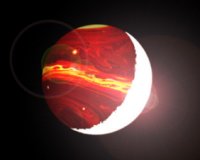 Help systemic search for and describe extrasolar planetary systems using professional astronomical images and data on the Internet. You do not need to have any prior experience or expertise with Astronomy to participate: you can learn everything you need to know through the project website. systemic is not an organized project: it provides tools to amateurs to conduct searches on their own. Amateurs who make discoveries need to publish their discoveries on their own. systemic's main page is a weblog about the latest discoveries in the fields of extrasolar planet discovery and solar system exploration. See more information about the project. To participate in the project, look for a collection of links on the right side of the main page, under the headers "Pages:" and "Links." These links explain how to participate in the "discovery and characterization of extrasolar planets." You can download a Java-based software package to work with extrasolar planet data and you can use the Systemic Backend collaborative environment to work with other amateur searchers. |
ongoing | N/A |
|
Help Galaxy Zoo classify over one million newly-discovered galaxies. The Sloan Digital Sky Survey (SDSS) is completing a detailed optical survey of over 1/4 of the sky and is generating a 3-dimensional map of over one million galaxies and quasars. Most of these galaxies have not been classified. Computers are not able to classify them easily, but humans are good at classifying them visually. See more information about the project. See the latest discoveries and project news in the project blog and twitter feed. The project is available in Polish On February 18, 2009, the project began Galaxy Zoo 2, which asks participants to provide more detailed classification data for the project's 250,000 "brightest and most interesting galaxies." The project reached its initial goal of 40 million classification by October 9, 2009. It reached 50 million clasisfications by December 2, 2009. It reached its goal of 60 million classifications on April 11, 2010. On April 23, 2010, the project began Galaxy Zoo Hubble, which asks participants to classify galaxies from hundreds of thousands of images from the Hubble Space Telescope. On May 30, 2008, the project was approved for 7 orbits of observation time from the Hubble Space Telecope (HST) sometime after the telescope is serviced in October, 2008. Galaxy Zoo will observe the Voorwerp object, which was first discovered by a Galaxy Zoo participant. On April 1, 2009, at about 7 PM EST (midnight UTC, April 2), the project began a challenge to classify 1 million galaxies in 100 hours, to celebrate 100 Hours of Astronomy. Project participants classified 1.5 million galaxies by the end of the challenge. Also, on April 3, 2009, the project classified its 20 millionth galaxy. On June 18, 2009, the project submitted its 11th paper, "Galaxy Zoo: Exploring the Motivations of Citizen Science Volunteers", to Astronomy Education Review. On August 5, 2009, the project submitted a new paper, "Reproducing Galaxy Morphologies Via Machine Learning." The paper demonstrates that by using the visual classifications generated by Galaxy Zoo to train an artificial neural network to identify galaxies, the network can identify new galaxies with greater than 90% accuracy. Computers will help humans keep up with the quickly increasing amounts of new data generated in the future. On January 13, 2010, a paper titled "Galaxy Zoo: Dust in Spirals" studying the dust content of spiral galaxies was published. On January 18, 2010, a paper on AGN host galaxies (galaxies whose supermassive black holes are feeding/growing) that the project submitted in 2009 was accepted by the Astrophysical Journal. The project began its bar drawing sub-project on September 18, 2009, and completed it on January 27, 2010. The project asked for participants' help "with more detailed classifications and to perform some new tasks for a selection of galaxies, some of which have 'bars'. We use the Google Maps interface to allow you to draw and manipulate lines and ellipses, performing crucial tests of automated pipelines and acquiring information which has never before been captured. On May 29, 2014, the project completed its work on infrared images from the UKIDSS survey. Over 80,000 volunteers classified over 70,000 images. The project will compare volunteers' classifications "to those from the Galaxy Zoo 2 project and study how morphology changes as a function of the wavelength in which those galaxies are observed." "Your help will enable us to better understand how bars effect their hosts. Our complete science rational can be seen here. To participate in the project, complete a tutorial to learn how to classify galaxies, then view images via the project website and classify them. Join a discussion forum about the project. |
ongoing | N/A |
|
Help Project Budburst track the dates on which native tree and plant species leaf or flower across the U.S. Data gathered from the project will help scientists track climate changes which might be caused by global warming. Results from the project will be available at the end of the blooming season, in about July, 2008. To participate in the project, follow the instructions on the Participate page. |
ongoing | N/A |
 Play the Foldit game to fold proteins into three-dimensional shapes and to help scientists to better predict how proteins fold into those shapes. Eventually participants will be able to design all-new proteins. Learn more about the science behind the game. The game "takes players through a series of practice levels designed to teach the basics of protein folding, before turning them loose on real proteins from nature. 'Our main goal was to make sure that anyone could do it, even if they didn't know what biochemistry or protein folding was.' At the moment, the game only uses proteins whose three-dimensional structures have been solved by researchers. But ...'soon we'll be introducing puzzles for which we don't know the solution.'" This project participated in the CASP8 protein structure prediction contest, which occured between May 5, 2008 and August 1, 2008. Results from the contest were released at the CASP meeting on December 3-7, 2008. To prepare for the contest, the project released some CASP warmup puzzles (Fibronectin, E. coli, Human Fyn 2, Transduction). In September, 2011, the project "helped discover the structure of an enzyme which could prove a significant step forward in the treatment and cure of retroviral diseases and even AIDS." See an article about the discovery. On January 16, 2015, the project completed its 1000th puzzle, an Ebola protein. On July 12, 2016, the project began its Tuberculosis Challenge to help fund a cure for this neglected disease. The challenge finished on July 19, 2016. On March 4, 2020, the project began several puzzles to help fight COVID-19 coronavirus, which caused a worldwide pandemic. To participate in the project, register for an account at the game's website, then download the Windows client and start playing. A Linux client may be available soon. A new version of the client (with many new features) was released on March 11, 2015. |
ongoing |
|
|
Help
Looking for Mars Polar Lander
find the Mars Polar Lander,
which crashed in 1999, by studying high-resolution images of the surface of
Mars from the area scientists predicted the lander crashed in. If the lander
is found, studying the condition of the lander may help determine the cause
of its crash.
To participate in the project, follow links to the project's web pages of images, view the images, and add a comment to the project's blog if you find anything interesting in the images. |
ongoing | N/A |
|
To participate in the project, click the "Give me a random speech that needs timestamping" link on the project website. On the next web page view the video and click the "Now" button when you hear the piece of text that is displayed below the video. Participants can register if they want to be included in the websites statistics rankings, but they can also participate without registering. |
ongoing; 22,126 speeches timestamped |
N/A |
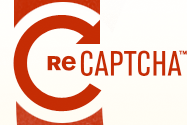 Help reCAPTCHA match non-machine-readable words from the Internet Archive's project to scan public domain books and make electronic versions of them available on the Internet. reCAPTCHA is technically a website security tool rather than a distributed human project, but the Internet Archive benefits when website users authenticate themselves using the tool. A reCAPTCHA shows an image of two words bisected by a line. One of the words is a control word and the other is a word from the Internet Archive project which needs to be interpreted. Computers could possibly scan and interpret all of the control words, but since each Internet Archive word is new, computers can't memorize the interpreted text. The interpreted words are reassembled into finished texts by the Internet Archives. From an August, 2008, news article: "In the first full year of reCAPTCHA's operations, 1.2 billion reCAPTCHA puzzles have been solved and more than 440 million words deciphered. This is the equivalent of manually transcribing more than 17,600 books. Four million words are now being transcribed per day." "It would take more than 1,500 people working 40 hours a week at a rate of 60 words a minute to match the weekly output of the CAPTCHA project. Amazingly, the reCAPTCHA team has managed to leverage unused human "cycles" for the common good." To participate in the project, incorporate the reCAPTCHA web service into your website or use this reCAPTCHA. You can also use a reCAPTCHA on the project's Learn More web page. |
ongoing | N/A |
 Help Project Squirrel better understand the ecology of squirrels in the United States. "By contributing your observations of squirrels from home, the office, school, a park, or anywhere, you are helping us better understand the ecology of our neighborhoods. Contribute data as often as you like, from anywhere you are." To participate in the project, follow the instructions on the Participate page. |
ongoing | N/A |
|
Help
Galaxy Zoo Mergers "understand
the cosmic collisions that lead to galaxy mergers." Participants will
help model a different galaxy each day by viewing a simulation of a merger
and comparing it with real astronomical images to determine the best merger
simulation.
The project's first paper, Galaxy Zoo: Bars in Disk Galaxies, a study of whether bars kill spiral galaxies, was accepted by the Monthly Notices of the Royal Astronomical Society on November 11, 2010. To participate in the project, study the How to Take Part page at the project website, then view images and simulations via the project website and classify the simulations. Join the Galaxy Zoo discussion forum. |
ongoing | N/A |
|
Help Moon Zoo create "detailed crater counts for as much of the Moon's surface as possible." This project is a Zooniverse project. Project participants view detailed images from NASA's Lunar Reconnaissance Orbiter and look for craters with boulders around their rims (boulders indicate that a crater impact was deep enough to excavate beneat the lunar soil) and identify the location and size of each relevant crater in the images. These counts allow scientists to determine how old each section of the moon's surface is. See more information about the project. Watch project participants' "walks on the moon" in real time with Moon Zoo Live. See the latest discoveries and project news in the Galaxy Zoo blog and twitter feed. To participate in the project, study the How to Take Part page at the project website, then view images of the moon's surface and mark craters in the images. Join the Moon Zoo discussion forum. |
ongoing | N/A |
|
Help the
NASA Be A Martian project
create more detailed maps of Mars, and count and classify craters on Mars, from
high-resolution images returned from Mars orbiters. Watch some videos to
learn about why the project is mapping Mars
and how to help.
To participate in the project, click one of the links on the Start Mapping page to Map Mars or Count Craters, then follow the instructions on the next page. You can create a free account on the site if you'd like to track your contributions: you may also participate anonymously. |
ongoing | N/A |
 Help the HiWish project decide which places on Mars the HiRISE imaging experiment on the Mars Reconnaisance Orbiter should photograph next. To participate in the project, create an account on the project website, browse the images that HiRISE has already captured, then suggest new locations. |
ongoing | N/A |
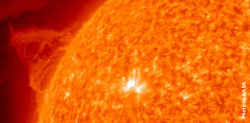 Help Solar Stormwatch "spot explosions on the Sun and track them across space to Earth. Your work will give astronauts an early warning if dangerous solar radiation is headed their way. And you could make a new scientific discovery." Participants view real-time images from the STEREO spacecraft to identify solar storms heading toward Earth and help create more accurate space weather forecasts. See the project's latest updates in its blog. The project released an animation "showing the activity of the solar wind throughout the first three years of the STEREO mission." The activity was determined by data analysis from the project's volunteers. To participate in the project, create an account on the project website and follow the instructions for participating. Join the Solar Stormwatch discussion forum. |
ongoing | N/A |
 Help Citizen Sky study the behavior of epsilon Aurigae, "a mysterious, bright, eclipsing binary variable star" which astronomers have studies since 1821 and which has not displayed predictable behavior. This star has an eclipse every 27.1 years and the eclipse lasts over 600 days. The most recent eclipse began in August, 2009. This project began in June, 2009, but still needs the help of citizen scientists to observe epsilon Aurigae, send their observations to the project, and then to see their results, analyze them, and even publish them in a scientific journal. See more information about the project and the project's blog. To participate in the project you do not need to have any astronomy experience and you do not need any equipment other than your eyes and a star finder chart which is available from the project website. Participants can learn from the project website how to participate in the project. Join the project's discussion forum. |
ongoing | N/A |
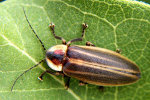 Help Firefly Watch determine whether fireflies are disappearing from North America. The Boston Museum of Science and researchers from Tufts University and Fitchburg State College are analyzing the observations of citizen scientists in North America to learn more about the "geographic distribution of fireflies and their activity during the summer season" and to study environmental factors affecting firefly habitats, such as human-made light and pesticides in lawns. Learn more about the project. Watch the project's progress on its online map. To participate in the project you do not need to have any specific scientific training. Learn more about getting involved. Join the project's discussion forum. |
ongoing | N/A |
 Help GLOBE at Night determine how much of the night sky people around the world can see and how much of it is blocked by light pollution. "GLOBE at Night is an annual 2-week campaign in March. People all over the world record the brightness of their night sky by matching its appearance toward the constellation Orion with star maps of progressively fainter stars. They submit their measurements on-line and a few weeks later, organizers release a map of light-pollution levels worldwide. Over the last four GLOBE at Night campaigns [2006-2009], volunteers from over 100 nations have contributed 35,000 measurements." Learn more about the project. The 2010 campaign began on March 3 and ended on March 16. Participants in 86 countries contributed over 17,800 measurements. See the measurement results. "The dots (or points) ... represent the contributed measurements of night sky brightness: the lighter colored the dot, the brighter the sky and the darker the dot, the darker the sky." In the 2011 campaign, nearly all of the 14,249 measurements were taken by 48 of the 115 registered countries. See general analysis and overall numbers of this campaign. In 2012 there are 4 campaigns: January 14-23, February 12-21, March 13-22, April 11-20. To participate in the project, follow the instructions on the project website. Subscribe to the project's mailing list to receive updates and results from the project. |
ongoing (at specific times of the year) | N/A |
 Help DarwinTunes create music through evolution. The project, developed at Imperial College London as a collaboration between Dr. Bob MacCallum, a bioinformaticist in the Laboratory of Immunogenomics at Imperial College London and Armand Leroi, Professor of Evolutionary Developmental Biology at Imperial College London, generates 4-measure pieces of "music," then invites participants to listen to the pieces and rate them on how much the participants like them, then new pieces based on the most-liked pieces of the previous generation. The project is experimenting with two types of music: one is free-form and the other includes prerecorded drum beats. The "beats" version was generated from the free-form version at the free-form version's generation 530. To participate in the project, follow the instructions on the project's participate page. Registration is optional. Join the project's discussion forum. |
ongoing | N/A |
 Help Google Image Labeler "label images and help improve the quality of Google's image search results." This project is similar to The ESP Game. The project presents a Java applet game to a pair of volunteers. The volunteers are shown a series of images and must type the same one-word description of an image within a time limit. The more images the pair tags, and the faster they type the same description, the more points they score. Each volunteer's points accumulate. The project associates a set of one-word descriptions for each of the images it indexes. To participate in the project, sign up for a user account or play as a guest, then click the "Start labeling" button. Your browser should load a Java applet in a new window and provide further instructions for playing the game. |
ongoing | N/A |
 Play the EVOKE social networking game "to come up with creative solutions to our most urgent social problems." The game is open to participants all over the world, ages 13 and older. During an active season of the game, players play the game for 10 weeks (they can join and play at any time during the season). Players who complete 10 game challenges successfully can claim "Certified EVOKE Social Innovator" honors. The project was developed by the World Bank Institute. See more information about the project. Season 1 began on March 3, 2010 and ended on May 12, 2010. Over 18,500 players or "agents" from over 150 countries completed more than 30,000 missions and quests. Season 2 is being designed as of May 7, 2010. To participate in the project, follow the directions on the project's How to Play page. |
ongoing | N/A |
 Help YourMorals understand the way humans' "moral minds" work. The project enables participants to learn about their "own morality, ethics, and/or values" while contributing to scientific research. The project is run by a group of professors and graduate students at the University of Virginia, the University of California (Irvine), and the University of Southern California. To participate in the project, create an account on the project website, then click the "Explore Your Morals" button. |
ongoing | N/A |
 Help Field Expedition: Mongolia "conduct a noninvasive survey in the region of the lost tomb of ruler Genghis Khan" by "tagging clues and artifacts on satellite images of the area." This project is sponsored by National Geographic. The project ends on July 29, 2010. See more information about the project and more information about the project's science. To participate in the project, register for an account, then log in and view satellite images, placing markers for roads, rivers, modern structures and other objects on the image. You will mark objects on a series of test images to learn what to look for in actual images. Note: you may need to scroll the image up, down, left and right with your mouse inside the image viewer to see all of the image. |
ongoing; 111,478 images/tiles processed as of July 13, 2010 |
N/A |
|
Play a game to help Phylo, "A
Human Computing Framework for Comparative Genomics," identify
Multiple Sequence Alignments,
sequences of proteins,
DNA or
RNA which are similar among
various species. Understanding these alignments can help biologists trace
the source of certain genetic diseases. The project is testing alignments from
UCSC Genome Browser, which were
created by computers using heuristic algorithms, and is applying human matching
techniques through an online game to find more optimized alignments. The
project is testing alignments related to human DNA, specifically to sequences
suspected to be linked genetic disorders such as breast cancer and epilepsy.
See more information about
the project/game.
To participate in the project, follow the links on the Play page to play a game. You may also play
the game in French |
ongoing | N/A |
|
Play The Space Game to help improve methods for designing interplanetary trajectories. The game is a crowdsourcing experiment run by the Advanced Concepts Team of the European Space Agency "to improve the methods for designing interplanetary trajectories. We do not claim that computers are not able or are particularly bad at solving such problems. Rather, we think that 'watching' humans design complex interplanetary trajectories can be of help to improve the intelligence of computer algorithms." See more information in the project's wiki. To participate in the project, read the instructions for How to Play, then register for an account if you wish to, and Play the game. Join the project's discussion forum. |
ongoing | N/A |
 Help Planet Hunters look for evidence of extrasolar planets (planets orbiting other stars) in public data from the Kepler space telescope. Volunteers study graphs of individual stars' brightness to look for patterns indicating whether a planet crossed in front of the star and temporarily made the star appear less bright. This experimental project will verify whether software algorithms which study the data are accurate or whether humans can detect patterns in the data that algorithms can't. It will also help scientists learn more about the different kinds of brightness patterns observed by Kepler. The project completed its 8 millionth classification on January 20, 2012. It also completed 1,084,760 classifications in 48 hours during a special BBC Stargazing Live event in the week of January 16, 2012. The project has discovered a new planet, named "Planet Hunters 2b," and 31 new planet candidates as of January 7, 2013. To participate in the project, create an account on the project website and follow the instructions for participating. Note that the project doesn't work with Internet Explorer yet: that problem should be fixed early in 2011. Join the Planet Hunters discussion forum. |
ongoing | N/A |
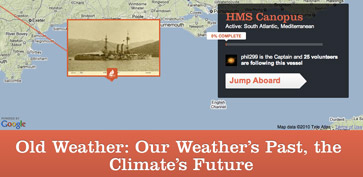 Help Old Weather create electronic versions of handwritten logs from 280 Royal Naval vessels during World War I. "Whether in battle, in port or on patrol, the ship's crew recorded information about the weather. That information is critical for climate scientists trying to improve their computer models. As well as rescuing those weather observations, we're also asking you to record the personal and political events aboard the ship. It's great fun and highly addictive: you have been warned!" As of August 23, 2011, the project has completed transcribing all of the log pages for 150 ships, over 89,000 pages of weather data. The project owners have created an overlay for Google Earth showing the routes (and the transcribed logs) of each of the 150 ships. As of October, 2012, the project is transcribing weather observations from ship logs of Arctic sea voyages back to 1850. Analyzing these weather data may give new insights into weather and climate. To participate in the project, create an account on the project website and follow the instructions for participating. Join the Old Weather discussion forum. |
ongoing | N/A |
|
To participate in the project, create an account on the project website, select one or more species to observe, and record your observations on the project website. |
ongoing | N/A |
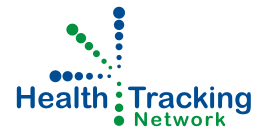 Help Health Tracking Network prevent influenza, the common cold, and stomach flu by tracking the spread of these diseases and discovering factors which contribute to the diseases. In this project, run by Interdisciplinary Scientific Research (ISR), a scientific research and consulting firm, participants spend two to three minutes per week answering questions about illness symptoms (and optionally tracking their own health and fitness in separate tracking tools). Their anonymous illness information is gathered to build a larger picture of the spread of these common diseases about which little is known. By participating in the project, participants can earn money for their favorite charities. See more information about the project and the project's FAQ. See the project's latest results. To participate in the project, register on the project's Join page and follow the instructions. |
ongoing; 105 total members as of May 14, 2011 | N/A |
|
Help the Earth Albedo project measure Earth's
albedo or reflecting power
each year on the
Summer solstice.
The project does not have a website. Project details are listed in a
TalkingScience blog posting and are listed below (any
sentences in quotes below are quoted directly from the blog posting to preserve
the information here in case the blog posting ever becomes unavailable. Thank
you to Lisa Gardiner for her original information in the blog posting).
Dr. Kathleen Gorsky began the project with her high school students at
Wilbrahim and Monson Academy near Springfield,
MA, in 2008. Each year the students collect images of a piece of white paper
placed on the ground in direct sunlight between 5 PM and 8 PM in the
photographer's local time zone on June 21. They compare the white paper in
each image to its surrounding ground surface and create scientific data that
they use to measure Earth's albedo, "the proportion of solar energy that
bounces back out to space when it hit's Earth's surface." "Understanding albedo
of the planet overall, and how albedo changes over time, tells us how much
solar energy is being held by the planet, which is important for understanding
climate." "Averaged out over the whole planet, earth’s albedo is currently
about 0.31 according to NASA and other scientific estimates. That means that
about a third of the sunlight that gets to earth is reflected out to space."
"The first year that Kathleen and her students did this project they had only
about 50 photos, yet they were able to calculate an albedo of 0.33 for the
planet using that data--not too far off."
This year (2011), Kathleen and her students will collect images from participants and "analyze the data, comparing the response of the white card to the response of the ground surface in each photograph using ImageJ software and will depict the data points on a map. They will be posting the results this fall on a new project website and Kathleen will be presenting about the project to teachers at the National Science Teachers Association meeting in Hartford, CT in the fall." Important: the project only needs images taken between 5 PM and 8 PM in the user's local time zone on June 21. Please do not send images from other times and/or dates. To participate, do the following:
|
ongoing | none |
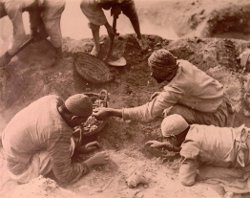 Help Ancient Lives translate text on papyrus sheets discovered in the 1,000-year-old town Oxyrhynchus in Egypt. This project is a Zooniverse project. "Ancient Lives is a collaboration between a diverse collection of Oxford Papyrologists and Researchers, The Imaging Papyri Project, The Oxyrhynchus Papyri Project, the Egypt Exploration Society and [several] institutions. The papyri belong to the Egypt Exploration Society and their texts will eventually be published and numbered in the Society's Greco-Roman Memoirs series in the volumes entitled The Oxyrhynchus Papyri. See more information about the project. To participate in the project, study the project's interactive tutorials for transcribing and measuring images of papyrus, then transcribe text from new images. You may participate anonymously or you may create an account if you wish to track your statistics. Join a discussion forum about the project. |
ongoing | N/A |
|
Help SETILive search "for interesting signals coming from the Kepler Field." The project is searching for evidence of extra-terrestrial radio signals from data from the field of stars being surveyed by the Kepler spacecraft. The data are provided by the SETI Institute's Allen Telescope Array. SETILive is a Zooniverse project. See more information about the project. To participate in the project, study the project's tutorial for identifying and classifying candidate radio signals in images of radio data, then classify signals in images from live telescope array data. You may participate anonymously or you may create an account if you wish to track your statistics. Join a discussion forum about the project. |
ongoing | N/A |
 Help data.rescue@home digitize historical weather data from all over the world. Data from the project will be made available to the public with no restrictions. "Two projects are currently online: German radiosonde data from the Second World War and meteorological station data from Tulagi (Solomon Islands) for the first half of the 20th century. The old data are expected to be very useful for different international research and reanalysis projects (e.g. ERA-CLIM, the Twentieth Century Reanalysis, new surface temperature datasets), and the prolongation of the currently available observational series into the past is of crucial importance for our understanding of the climate system." To participate in the project, create an account on the project website and follow the instructions for participating. |
ongoing | N/A |
|
Help Whale FM group similar-sounding whale calls. Categorizing these calls helps marine scientists learn what whales are saying. Whale FM is a Zooniverse project. See more information about the project. To participate in the project, study the project's tutorial for listening to a whale call and finding the best match for it from a group of sounds. You may participate anonymously or you may create an account if you wish to track your statistics. |
ongoing | N/A |
 As of March 30, 2012, over 83% of all public paintings have been photographed and 6,143 paintings have been tagged and classified. To participate in the project, click the "Start Tagging" button on the project's main page. You can click the "Try it out" button to try classifying five paintings (your classifications for these paintings won't be saved) or you can register for a free account and start classifying actual paintings. |
6,419 taggers have tagged 6,143 paintings with 1.9 million tags as of March 30, 2012 | N/A |
 Help EteRNA learn more about how life works at a cellular level. Participants play a game in which they design synthetic RNA (Ribonucleic Acid) molecules, tiny molecules that exist in every cell. If a participant wins the weekly competition, his or her RNA molecule is synthesized and scored by how well it folds into a three-dimensional structure. See more information about the project and the project's wiki. The project was developed by Carnegie Mellon University and Stanford University. To participate in the project, register for an account on the project website and select one of the project's puzzles, challenges or labs. You may also click the "Play Tutorial" button on the project's main page to try the game's tutorial without registering for an account. Join a discussion forum about the project. |
ongoing | N/A |
|
Help FreeCell Project solve 99.9% of the 1,000,000 freecell games available in Windows XP. This project is based on The Internet FreeCell Project, one of the earliest Internet crowdsourcing projects, which in 1994 and 1995 solved all but one of the 32,000 possible games in Microsoft FreeCell. Read more about that project in an article. This project asks participants to find solutions for the 1,000,000 possible games in 100 10,000-game "seasons." When 10 or fewer games in one season are unsolved, the project moves on to the next season. See more information about this project. To participate in the project, choose the Classic FreeCell Project, a web-based FreeCell game player, or the Facebook FreeCell Project, a Facebook app which plays the FreeCell game and which has more features. You can participate anonymously or create an account to track your contribution statistics. |
season #361 is 10% complete as of April 27, 2012 | N/A |
|
Help What's the Score at the Bodleian? describe over 4,000 images of piano music scores from the Bodleian library. No catalogue exists for these scores from the mid-Victorian time period. "The music was mostly produced for domestic entertainment, and many of these scores have illustrated or decorative covers and advertisements." Participants do not need to know how to read music to make a useful contribution to the project. The project owners hope that participants with musical ability will record performances of some of the songs and will provide links to the recordings. This project is a Zooniverse project. See more information about the project and the project's blog. To participate in the project, create a Galaxy Zoo account and click the project's Start describing button to view and describe piano scores. |
ongoing | N/A |
|
Help The Milky Way Project catalog and classify material--"bubbles"--in images from the Spitzer Space Telescope. Understanding this material helps scientists "learn how stars form and understand how our galaxy changes and evolves with time." This project is a Zooniverse project. See more information about this project and the project's blog. To participate in the project, create a Galaxy Zoo account and click the project's Bubbles button. Join a discussion forum about the project. |
ongoing | N/A |
 Help Biogames make medical diagnoses for real patients from medical images via a "game" that you play in your web browser or on your cell phone or tablet computer. The project uses crowdsourcing to view medical images, such as images of cells, to determine whether particular cells are healthy or diseased. The project's first goal is to prove that untrained "crowds" can make diagnoses nearly as accurate as trained professionals. See more information about the project. Biogames' first project diagnoses patients for malaria, a disease which infects about 500 million people and kills about 3 million people worldwide every year. Many of these people live in poorer countries and can't afford proper medical care to diagnose and treat the disease. To participate in the project, view the project's instructions, then register for an account and log in to play the game. |
ongoing | N/A |
 Help Seafloor Explorer "identify species and ground cover in images of the seafloor, and help create a library of seafloor life in the habitats along the [North American] northeast continental shelf." The project analyzes images from the HabCam optical imaging system from the Woods Hole Oceanopgraphics Institution. This project is a Zooniverse project. See more information about this project and the project's blog. To participate in the project, create a Galaxy Zoo account and click the project's button. Join a discussion forum about the project. |
ongoing: 458,465 images classified as of Spetember 21, 2012 |
N/A |
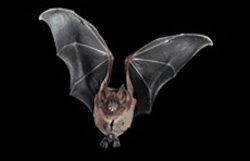 Help Bat Detective classify bat calls from audio recordings collected all over the world. "By sorting the sounds in the recordings into insect and bat calls, bat detectives will help biologists learn how to reliably distinguish bat 'tweets' to develop new automatic identification tools." This project is a scistarter project. See more information about this project and the project's blog. To participate in the project, register for an account, then click the project's join in link. Join a discussion forum about the project. |
ongoing | N/A |
 Help Cyclone Center classify "over 30 years of tropical cyclone satellite imagery" for use by climate scientists. "The global intensity record contains uncertainties caused by differences in analysis procedures around the world and through time. Scientists are enlisting the public because patterns in storm imagery are best recognized by the human eye." This project is a Zooniverse project. See more information about this project and the project's blog. To participate in the project, create a Galaxy Zoo account (optional) and click the project's Begin classifying button. Join a discussion forum about the project. |
ongoing | N/A |
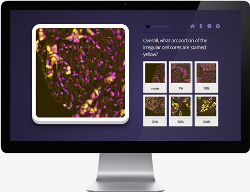 Help ClicktoCure discover new and more effective ways to detect and cure cancer. In this project, managed by Cancer Research UK, participants view images from a collection of over two million images of actual cells and identify which cells in the images are cancer cells. This work is very difficult for computers to do but is much easier for humans to do. By analyzing images of patients' cells before and after cancer treatments, scientists can determine which treatments are more effective for which patients. See more information about this project. This project is a Zooniverse project. To participate in the project, click the project's Join the fight button, create a Zooniverse account (optional) if you want to track your contributions to the project, then click the "Let's go!" button to begin the tutorial and learn how to identify cancer cells in the project's images. |
ongoing;106,723 images analyzed as of October 30, 2012 | N/A |
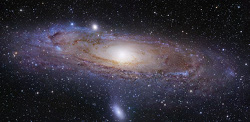 Help The Andromeda Project discover and classify star clusters within the Andromeda Galaxy, a spiral galaxy about 2.5 million light years away from Earth. Studying star clusters helps scientists learn how stars--and spiral galaxies--form and evolve. The project is using images from the Panchromatic Hubble Andromeda Treasury (PHAT) survey. These images are being collected from the Hubble Space Telescope over four years. See more information about this project and the project's blog. This project is a Zooniverse project. The project completed Round 1 of processing before the end of 2012. It will not collect results from Round 1 images processed after 2012, but participants may still classify them. More data for the project will be available some time in 2013. To participate in the project, click the project's Start Classifying button or create a Zooniverse account (optional) if you want to track your contributions to the project. Join a discussion forum about the project. |
Round 1 completed December, 2012; Round 2 will begin sometime in 2013 | N/A |
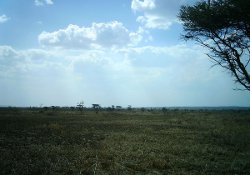 Help Snapshot Serengeti find and identify animals in images from more than 200 motion-activated cameras in Serengeti National Park, a UNESCO World Heritage Site in Tanzania. This project will provide the data needed by scientists at the University of Minnesota to track and study these animals. The project is analyzing over 4.5 million images taken by the cameras since 2010. See more information about this project and the project's blog. This project is a Zooniverse project. The project completed processing seasons 1 through 3 by January 4, 2013 and began processing season 4 on January 11, 2013. The project had such an overwhelming number of participants that the work for images from the first three seasons--which was expected to be completed in two months--was completed in one week. To participate in the project, click the project's Start Classifying button or create a Zooniverse account (optional) if you want to track your contributions to the project. Join a discussion forum about the project. |
ongoing | N/A |
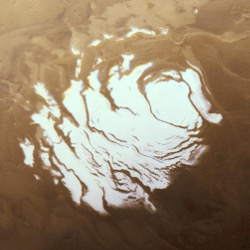 Help Planet Four "identify and measure features on the surface of Mars ... the likes of which don’t exist on Earth. All of the images on this site depict the southern polar region, an area of Mars that we know little about, and the majority of which have never been seen by human eyes before!" Participants are finding and marking "‘fans’ and ‘blotches’ on the Martian surface. Scientists believe that these features indicate wind direction and speed. By tracking ‘fans’ and ‘blotches’ over the course of several Martian years to see how they form, evolve, disappear and reform, we can help planetary scientists better understand Mars’ climate. We also hope to find out if these features form in the same spot each year and also learn how they change." The project's images "come from the HiRISE (High Resolution Imaging Science Experiment) camera on board the Mars Reconnaissance Orbiter. HiRISE can image Mars with resolutions of 0.3 m/pixel (about 1 foot), resolving objects below a meter across." The project classified its 4 millionth image on October 29, 2013. See more information about this project and the project's blog. This project is a Zooniverse project. To participate in the project, click the project's Classify button or create a Zooniverse account (optional) if you want to track your contributions to the project. Join a discussion forum about the project. |
76,956 participants have classified over 4 million images as of November 26, 2013 | N/A |
 Help Notes from Nature transcribe records of historical biodiversity data from museum collections. "Scientists and researchers can use the data to conduct new research and make better conservation decisions. The digitized data you are creating will help advance research related to species extinction, ecosystem changes, environmental health and even human health." See the collections on which the project is currently working. See more information about this project and the project's blog. This project is a Zooniverse project. To participate in the project, click the project's Start Transcribing button or create a Zooniverse account (optional) if you want to track your contributions to the project. Join a discussion forum about the project. |
22.3% (55,988 transcriptions) as of April 29, 2013 | N/A |
|
Help Lab in the Wild test people's cultural preferences and perception. The project runs several experiments (listed on the project's main page), to help the project owners learn about the similarities and differences between people from around the world when interacting with technology and learn how people of different cultures perceive information. The project is run by several computer scientists at Harvard. See more information about this project and the project's blog. To participate in the project, click a link for one of the project's experiments. Participation in the experiments is anonymous. |
ongoing | N/A |
 Help Test My Brain learn more about how the mind and brain work (and learn more about yourself) by participating in the project's various experiments. The project is run by the Harvard University Vision Sciences Laboratory. See more information about this project, the project's FAQ, and the project's blog. See publications based on results of the project. To participate in the project, click the "GO!" button next to one of the experiments on the project's main page. Participation is anonymous. Join a discussion forum about the project. |
ongoing | N/A |
|
Help Space Warps find rare gravitational lenses galaxies so large they bend light around them, allowing us to see galaxies behind them. See more information about the project's science and the project's FAQ. This project is a Zooniverse project. To participate in the project, click the project's Classify button or create a Zooniverse account (optional) if you want to track your contributions to the project. Join a discussion forum about the project. |
ongoing | N/A |
|
Play a free mobile game to help Play to Cure: Genes in Space analyze real genetic data to find cancer cures. This is the first mobile game to contribute useful work to a scientific research project. The project is owned and managed by Cancer Research UK. See more information about the game and a short video about the game. The game is available for iOS and Android. To participate in the project, download the game application to your mobile device by following the instructions on the project website. You can play the game and participate in the project anonymously or you can create a free account to track your progress. |
ongoing | N/A |
|
Help Tomnod solve real-world problems by exploring satellite images of Earth. The project is owned by DigitalGlobe. The project runs several campaigns at a time and starts new campaigns frequently. Check the project website for information abouts its current and past campaigns. See the project's blog. To participate in the project, follow the instructions on the project website. You can participate anonymously or register your email address to track your contribution statistics. |
ongoing | N/A |
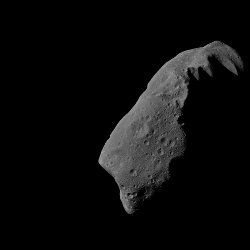 Help Asteroid Zoo find asteroids in our solar system so that scientists can study their mineral properties. Learning about these properties will help scientists learn more about how planets form and evolve. Also, identifying undiscovered near-Earth asteroids may help us avoid future collisions with them. See more information about the project and its science. This project is a Zooniverse project. To participate in the project, click the project's Start Hunting button or create a Zooniverse account (optional) if you want to track your contributions to the project. Join a discussion forum about the project. |
ongoing | N/A |
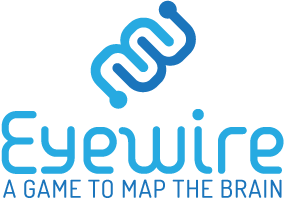 Help Eyewire map the 3D structure of neurons in the human brain. See more information about the project. See the project's blog and wiki To participate in the project, create an account, then click the Start Playing button. Note that the project does not work with the Internet Explorer web browser. Follow the tutorial, then practice with some practice cubes, then start mapping neurons. You can track your overall contributions to the project in your profile. Join a discussion forum about the project. |
ongoing | N/A |
 Help Floating Forests identify, and track changes in, Giant Kelp forests from satellite images over the past 30 years. Tracking changes in kelp forests can identify problems in the health of coastal ecosystems. See more information about the project and the project's blog. This project is a Zooniverse project. The project completed 2,000,000 classifications on July 18, 2015. To participate in the project, click the project's Get Started button or create a Zooniverse account (optional) if you want to track your contributions to the project. Join a discussion forum about the project. |
ongoing | N/A |
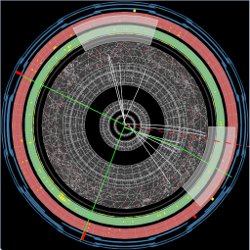 Help Higgs Hunters indentify possible Higgs boson subatomic particles, and possibly other unknown, exotic particles, in images of particle collisions from the Large Hadron Collider. Humans are better at identifying these tracks than computers. See the project's blog. This project is a Zooniverse project. To participate in the project, click the project's Get Started button or create a Zooniverse account (optional) if you want to track your contributions to the project. Join a discussion forum about the project. |
ongoing | N/A |
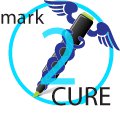 Help Mark2Cure "organize biomedical knowledge and uncover hidden links" by reading and annotating biomedical documents. See the project's blog. The project completed its first beta experiment on February 18, 2015. 212 volunteers submitted 10,345 document annotations in just over 4 weeks. To participate in the project, follow the instructions on the project website. |
waiting for next round to begin | N/A |
 Help Worm Watch Lab study videos of nematode worm behavior to discover "how genes affect behaviour in nematode worms. These discoveries can help us understand our own genes, too." "By watching a short video and spotting the worms laying eggs we can understand better how our genes work." See the project's blog. This project is a Zooniverse project. To participate in the project, click the project's Get Hunting! button or create a Zooniverse account (optional) if you want to track your contributions to the project. Join a discussion forum about the project. |
ongoing | N/A |
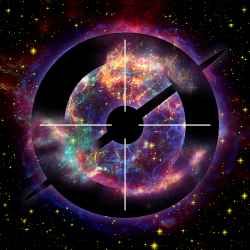 Help Snapshot Supernova look for new supernovae. "The Zooniverse has joined with the team from the Skymapper Telescope in Siding Spring, Australia, and BBC Stargazing Live to bring you Snapshot Supernova. We need your help to look through images of the night sky for exploding stars. These supernovae events can get so bright that they outshine their host galaxies for a few days or weeks. Discovering a certain type of supernova allows astronomers to refine their measurements of many fundamental parameters of the Universe, such as its age." See more information about the project's science. See the project's FAQ. This project is a Zooniverse project. To participate in the project, click the project's Start Hunting! button or create a Zooniverse account (optional) if you want to track your contributions to the project. Join a discussion forum about the project. |
ongoing | N/A |
|
Help Science Gossip classify drawings from Victorian-era periodicals and "map the origins of citizen science." See more information about the project. See the project's blog. This project is a Zooniverse project. To participate in the project, click the project's Get started! button or create a Zooniverse account (optional) if you want to track your contributions to the project. Join a discussion forum about the project. |
ongoing | N/A |
|
Help Building Inspector, a New York Public Library project, train computers "to recognize building shapes and other data on digitized insurance atlases" of New York City by visually identifying these objects and verifying the computers' work. This project supports the NYC Space/Time Directory project. See more information about the project. To participate in the project, click the project's GET STARTED button or create an account to track your progress. |
ongoing | N/A |
|
Help Wildsense contribute to scientific research by discovering more information about wildlife. See more information about the project and the project's blog. Wildsense's first project is studying wild tigers, an endangered species: it uses a Wildsense Tigers iOS application which asks participants to mark images of wild tigers to help count, track, and study the behaviors of tigers around the world. To participate in the project, download the project's Wildsense Tigers iOS app to your iPhone or iPad and follow the instructions in the app. |
ongoing | N/A |
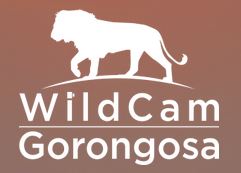 Help WildCam Gorongosa document the recovery of wildlife in Gorongosa National Park in Mozambique. Participants identify animals in trail camera photos from the park to help document the restoration of the park's wildlife. See more information about the project. See the project's blog. This project is a Zooniverse project. To participate in the project, click the project's Get Started! button or create a Zooniverse account (optional) if you want to track your contributions to the project. Join a discussion forum about the project. |
ongoing | N/A |
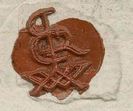 Help Shakespeare's World build a better understanding of William Shakespeare's life and times. Volunteers transcribe documents hand-written by Shakespeare's contemporaries. Learn more about the project. See the project's blog. To participate in the project, click the project's Get started button or create a Zooniverse account (optional) if you want to track your contributions to the project. Join a discussion forum about the project. |
ongoing | N/A |
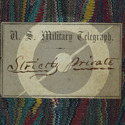 Help Decoding the Civil War researchers learn more about the American Civil War by "transcribing and deciphering messages and codes from the United States Military Telegraph." See more information about the project. See the project's blog. This project is a Zooniverse project. To participate in the project, click the project's Get started! button or create a Zooniverse account (optional) if you want to track your contributions to the project. Join a discussion forum about the project. |
ongoing | N/A |
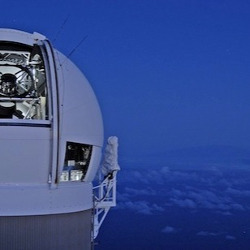 Help Supernova Hunters discover supernovae in images from the Pan-STARRS1 telescope. Learn more about the project. To participate in the project, click the project's Classify button or create a Zooniverse account (optional) if you want to track your contributions to the project. Join a discussion forum about the project. |
ongoing | N/A |
|
Help Pulsar Hunters discover new pulsars hidden in radio data. Studying pulsars helps scientists test Einstein's general theory of relativity and alternative theories of gravity. See more information about the project. This project is a Zooniverse project. To participate in the project, click the project's Get started! button or create a Zooniverse account (optional) if you want to track your contributions to the project. Join a discussion forum about the project. |
ongoing; 3,364,129 classifications on 12,357 (753 retired subjects) as of July 26, 2016 | N/A |
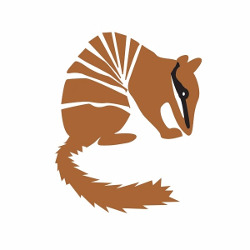 Help Western Shield - Camera Watch identify animal species in nighttime photographs of Western Australia's northern jarrah forests to help scientists control feral fox and feral cat populations and protect the native species in those areas. Learn more about the project. To participate in the project, click the project's Classify button or create a Zooniverse account (optional) if you want to track your contributions to the project. Join a discussion forum about the project. |
ongoing | N/A |
 Help Planet Four: Terrains characterize surfaces on Mars by examining images from the Mars Reconnaisance Orbiter's Context Camera. See more information about the project. See the project's blog. This project is a Zooniverse project. To participate in the project, click the project's Get started! button or create a Zooniverse account (optional) if you want to track your contributions to the project. Join a discussion forum about the project. |
ongoing | N/A |
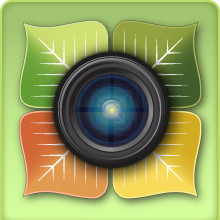 Help Season Spotter Jornada study impacts of changing climate by spotting seasonal changes in images of the Jornada Experimental Range in Mexico. This projhect is an offshoot of the Season Spotter project. Learn more about the project. To participate in the project, click the project's Classify button or create a Zooniverse account (optional) if you want to track your contributions to the project. Join a discussion forum about the project. |
ongoing | N/A |
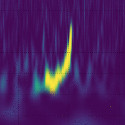 Help Gravity Spy characterize types of glitches in images of Laser Interferometer Gravitational-Wave Observatory (LIGO) data to train computers to identify gravitational waves more efficiently. See more information about the project. See the project's FAQ. See the project's results. See the project's blog. This project is a Zooniverse project. To participate in the project, click the project's Get started! button or create a Zooniverse account (optional) if you want to track your contributions to the project. Join a discussion forum about the project. |
ongoing | N/A |
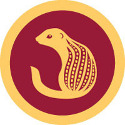 Help Mapping Change transcribe over 4 million specimen labels for the Bell Museum of Natural History to map the effects of human change on biodiversity in the U.S. upper midwest, to "understand and respond to the changes that plants, animals, fungi and other living things are experiencing as humans alter the world’s habitats and climate." Learn more about the project. See the project's blog. To participate in the project, click the project's Get started! button or create a Zooniverse account (optional) if you want to track your contributions to the project. Join a discussion forum about the project. |
ongoing | N/A |
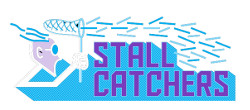 Help Stall Catchers identify causes of reduced blood flow in the brain, a know cause of Alzheimer's disease and other forms of dementia. Volunteers look at images from a virtual microscope to identify whether a specific blood vessel (capillary) has "stalled" bloodflow (where blood is no longer flowing). In Alzheimer's disease patients, about 2% of the smallest blood vessels in the brain can become blocked, causing a 30% reduction in overall bloodflow. Analyzing 1 hour of brain blood vessel imaging data can take 1 researcher 1 week: volunteers can speed up the analysis process significantly and can help researchers make discoveries much more quickly. See more information about this project. See the project's FAQ. This is the first project from EyesOnALZ. To participate in the project, click the project's "Start here" button to view a short tutorial video. Then create an account for the project or log in with your Facebook or Google account to start classifying images. Join a discussion forum about the project. |
ongoing | N/A |
 Help Focus on Wildlife -- Cleveland Metroparks improve wildlife conservation efforts in the 23,000 acre Cleveland Metroparks system of nature reserves in Ohio. Volunteers analyze thousands of images from cameras in the parks and identify animal species. Learn more about the project. To participate in the project, click the project's Species Identification button or create a Zooniverse account (optional) if you want to track your contributions to the project. Join a discussion forum about the project. |
ongoing | N/A |
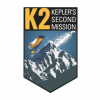 Help Exoplanet Explorers search through data from the Kepler space telescope to find planets orbiting distant stars. Zooniverse is running this project together with the Australian television show Stargazing Liveand with a team of astronomers from UC Santa Cruz in California. See more information about the project. See the project's FAQ. See the project's results. This project is a Zooniverse project. To participate in the project, click the project's Get started button or create a Zooniverse account (optional) if you want to track your contributions to the project. |
ongoing | N/A |
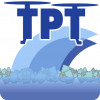 Help The Plastic Tide enable scientists to study the amount of plastic waste on coastlines and help train computers to identify plastic waste in images of coastline from drones. See more information about the project. See the project's FAQ. See the project's results. This project is a Zooniverse project. To participate in the project, click the project's Get started button or create a Zooniverse account (optional) if you want to track your contributions to the project. Join a discussion forum about the project. |
ongoing | N/A |
 Help Michigan ZoomIN study spatial patterns between carnivores and their prey throughout the state of Michigan by identifying and describing animal species in images from wildlife surveys. See more information about the project. See the project's FAQ. See the project's results. This project is a Zooniverse project. To participate in the project, click the project's Get started button or create a Zooniverse account (optional) if you want to track your contributions to the project. Join a discussion forum about the project. |
ongoing | N/A |
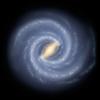 Help Galaxy Bars enable scientists to study how "bar" formations in galaxies form and evolve. See more information about the project. See the project's FAQ. See the project's results. This project is a Zooniverse project. To participate in the project, click the project's Get started button or create a Zooniverse account (optional) if you want to track your contributions to the project. Join a discussion forum about the project. |
ongoing | N/A |
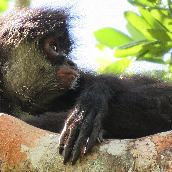 Help Spotting Spider Monkeys study deforestation and habitat loss by training an algorithm to "spot and monitor spider monkey populations in the tropical forests of Central and South America." Volunteers can "help scientists by looking for spider monkeys in infrared drone footage clips of Central American forests and tagging them. The tags will train the machine-learning algorithm to track spider monkeys on its own, saving researchers hundreds of hours of time." The project hopes to tag 17,000 infrared videos of spider monkeys. This project is run by the British Science Association and is being led by Dr. Claire Burke of the Astrophysics Research Institute at Liverpool John Moores University. See more information about the project. This project is a Zooniverse project. To participate in the project, click the project's Get started button or create a Zooniverse account (optional) if you want to track your contributions to the project. Join a discussion forum about the project. |
ongoing | N/A |
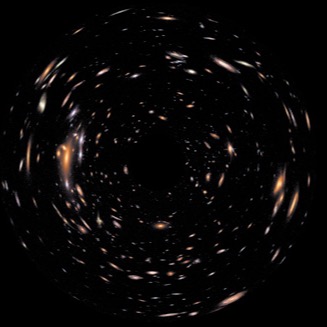 Help Dark Energy Explorers determine which galaxies found by HETDEX "come from [the project scientists'] epoch of interest (10-11 billion years ago at z~2-3) and which ones are nearby." HETDEX, the Hobby-Eberly Dark Energy Experiment, "will find over one million galaxies that are 9 billion to 11 billion light-years away, yielding the largest map of the universe ever produced." See more information about the project. See the project's FAQ. See the project's results. This project is a Zooniverse project. To participate in the project, click the project's Get started button or create a Zooniverse account (optional) if you want to track your contributions to the project. Join a discussion forum about the project. |
ongoing | N/A |
| See more Distributed Human projects at Science for Citizens, Scientific American Citizen Science, Citizen Science Center and CrowdCrafting. If you have an Android phone you can donate its computing power while it is charging via HTC's Power to Give project. |
| The following icons may appear in the Supported Platforms section of the table: | |||||||||||||
|
| Top... |